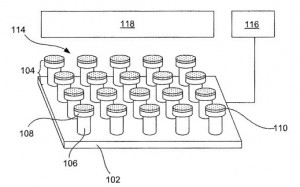The Hewlett-Packard Company (NYSE: HPQ) of Palo Alto, CA, is a leading developer in the information technology industry and sells a vast array of computing products encompassing hardware devices and software solutions. This corporation is poised for a major restructuring in the coming months after the October 2014 announcement of the split of this company into two publicly-traded companies by the end of 2015, which will effectively separate the hardware and software operations of HP. The company’s personal computer sales have been strong recently with 15.9 million PC units shipped in the fourth quarter of 2014, earning the company a nearly 20 percent market share. HP has also announced plans to enter the realm of 3D printers for consumers by 2016, joining a sector of technology which is becoming much more crowded as our coverage of the 2015 Consumer Electronics Show indicates.
Hewlett-Packard is consistently near the top of the food chain when it comes to patents granted in recent years by the USPTO. During 2013, the company placed 21st worldwide with 1,459 patents issued from the USPTO, an increase of only one percent from the previous year. HP claims a very broad patent portfolio with protected technologies in many fields including imaging, printing, personal computers, displays, computer networking and data storage. During November of last year, Hewlett-Packard sold an undisclosed number of patents related to lighting and building systems technologies to tech innovation and licensing company WiLAN. In that same month, HP was the target of a lawsuit filed by Cedatech Holdings LLC of Texas for infringement of a patent purchased by Cedatech protecting the integration of an audio or video program with a separate application.
Hewlett-Packard has some ambitious plans in terms of information technology innovation. The Palo Alto-based HP Labs is the epicenter of development for what the company hopes will be the greatest advancement in computing architecture since the creation of the Von Neumann architecture established during the 1940s, an HP project which is simply referred to as “the Machine.” This corporation operates a network of research and development facilities, including innovation centers in both Geneva and Dubai which both focus on information technology inventions to benefit businesses. One intriguing business technology created by HP, the HP Zvr virtual reality display platform for business and enterprise applications, turned heads at the most recent Consumer Electronics Show in Las Vegas.
[Companies-1]
Today we engage in our latest Companies We Follow survey of Hewlett-Packard inventions. A number of patent applications recently published by the U.S. Patent and Trademark Office show an HP focus on ink products, including one electronic ink for use in digital displays that maintains an image while entering a low charge state. A few other attention grabbing patent applications disclose improvements in stem cell research as well as a mass spectrometry system for complying with federal regulations regarding metals mined from global areas experiencing civil unrest.
Hewlett-Packard’s Patent Applications: From Innovative Inks to Stem Cell Research
The Hewlett-Packard Company has built a strong market presence for its printing products so it wouldn’t be surprising to see it pursuing innovations in ink products. Improvements to the use of metallic pigments which achieve a more desirable optical density during printing is the focus of U.S. Patent Application No. 20140342279, entitled Polymer-Encapsulated Metallic Ink Particles and Metallic Electrophotographic Inks. The method for making polymer-encapsulated metallic ink particles claimed here involves forming an ethylene-based polymeric resin powder, mixing that powder with a metallic pigment powder to form a powder mixture, melting that mixture to form a metallic powder melt, adding a non-polar carrier and processing the resulting slurry in a microfluidizer. The resulting metallic electrophotographic ink has a reduced flop index, or a reduced change in the lightness of a metallic color when viewed at different angles. Not every HP ink innovation we viewed is focused on traditional print media, however, as is evidenced by U.S. Patent Application No. 20140376082, filed under the title Multi-Stable Electronic Inks. This patent application would protect a compound that includes a segment formed of hydrocarbons having either nitrogen or oxygen in the carbon backbone, as well as other hydrocarbon segments. The compound is used as a multi-stable ink for an electrokinetic display that can maintain an image or text when the display power is reduced or turned off entirely.
 We noted some other interesting HP inventions that center on techniques for deriving meaningful and valuable information from the incredible amounts of information available through computer networks. Drawbacks to the browsing of document content through the use of a mobile device are addressed by U.S. Patent Application No. 20140304264, entitled Mobile Web-Based Platform for Providing a Contextual Alignment View of a Corpus of Documents. The computer-implemented method that would be protected provides a mobile, web-based contextual alignment view of a corpus of documents by mining those documents for a set of topics, analyzing documents to determine a set of opinions and a corpus opinion associated with the set of topics, classifying documents based on their alignment with the corpus opinion and presenting the corpus to a user based on this classification. This system enables a more efficient process for viewing relevant documents contained within a large corpus of documents on a mobile device. Enhanced methods of collecting and processing information relevant to social network providers is discussed within U.S. Patent Application No. 20150006241, which is titled Analyzing Participants of a Social Network. This invention is directed at analyzing the behaviors, relationships, activities and other data related to individual social network participants to determine insights into how the social media service may be improved or how to encourage individuals to engage in purchasing activities. The patent application claims a method of analyzing participants of a social network by accessing data related to a plurality of participants, creating a query containing a plurality of attributes, including social network and business value attributes, associated with the participants, evaluating participant data based on the query and computing the identified attributes based on the participant data.
We noted some other interesting HP inventions that center on techniques for deriving meaningful and valuable information from the incredible amounts of information available through computer networks. Drawbacks to the browsing of document content through the use of a mobile device are addressed by U.S. Patent Application No. 20140304264, entitled Mobile Web-Based Platform for Providing a Contextual Alignment View of a Corpus of Documents. The computer-implemented method that would be protected provides a mobile, web-based contextual alignment view of a corpus of documents by mining those documents for a set of topics, analyzing documents to determine a set of opinions and a corpus opinion associated with the set of topics, classifying documents based on their alignment with the corpus opinion and presenting the corpus to a user based on this classification. This system enables a more efficient process for viewing relevant documents contained within a large corpus of documents on a mobile device. Enhanced methods of collecting and processing information relevant to social network providers is discussed within U.S. Patent Application No. 20150006241, which is titled Analyzing Participants of a Social Network. This invention is directed at analyzing the behaviors, relationships, activities and other data related to individual social network participants to determine insights into how the social media service may be improved or how to encourage individuals to engage in purchasing activities. The patent application claims a method of analyzing participants of a social network by accessing data related to a plurality of participants, creating a query containing a plurality of attributes, including social network and business value attributes, associated with the participants, evaluating participant data based on the query and computing the identified attributes based on the participant data.
Some of the IT innovations we saw coming out of the research facilities of Hewlett-Packard were focused on some incredibly novel services, including the management system for special occasions outlined within U.S. Patent Application No. 20140324502, which is titled Coordinating a Plurality of Celebratory Events for an Honoree. The invention is designed to automate some of the planning of celebratory events or actions so as to maximize relaxation for a person celebrating a birthday, anniversary or other kind of special event. The central server for coordinating celebratory events for an honoree claimed here includes a user selection module that provides central server access to a user for selecting a service to support the celebratory event, a third party selection module for selecting third party services to support the event and a calendar coordination module for a user to select the time when services are provided to the honoree.
Other HP patent applications that we took note of establish some company goals outside of the development of IT devices and services for strictly business purposes. Regulatory compliance with the Dodd-Frank Wall Street Reform and Consumer Protection Act is the focus of U.S. Patent Application No. 20140324347, filed under the title Determining the Geographic Origin of Metals. The method for determining a metal’s geographic origin claimed here involves measuring multiple isotopes of the metal through high-resolution mass spectrometry, calculating a ratio of two isotopes, comparing that ratio to a database storing data on native ratios of isotopes in various geographic locations and matching the ratio of the metal sample to a geographic location. This innovation for identifying the origin of mined metals is intended to identify if a mined metal comes from an area of the world experiencing civil unrest to prevent money from traveling to those regions of the world. We were also greatly intrigued to see Hewlett-Packard involved in the world of stem cell research, which is described by U.S. Patent Application No. 20140370493, entitled Method for Monitoring and Controlling Cellular Growth. This patent application claims a method of growing live cells by disposing live cells on a device with a substrate comprised of elongated nanostructures having both an attachment end and a free end, the free end  comprised of a metal and a functionalization layer that coats a portion of the free ends on the substrate and associating the substrate with a detector capable of monitoring the live cells. This enhanced system of cellular monitoring improves the success of stem cell bioprocessing by eliminating the use of metallic particles designed for monitoring cells, which can affect cell growth and processing.
comprised of a metal and a functionalization layer that coats a portion of the free ends on the substrate and associating the substrate with a detector capable of monitoring the live cells. This enhanced system of cellular monitoring improves the success of stem cell bioprocessing by eliminating the use of metallic particles designed for monitoring cells, which can affect cell growth and processing.

![[IPWatchdog Logo]](https://ipwatchdog.com/wp-content/themes/IPWatchdog%20-%202023/assets/images/temp/logo-small@2x.png)

![[Advertisement]](https://ipwatchdog.com/wp-content/uploads/2024/04/Patent-Litigation-Masters-2024-sidebar-early-bird-ends-Apr-21-last-chance-700x500-1.jpg)

![[Advertisement]](https://ipwatchdog.com/wp-content/uploads/2021/12/WEBINAR-336-x-280-px.png)
![[Advertisement]](https://ipwatchdog.com/wp-content/uploads/2021/12/2021-Patent-Practice-on-Demand-recorded-Feb-2021-336-x-280.jpg)
![[Advertisement]](https://ipwatchdog.com/wp-content/uploads/2021/12/Ad-4-The-Invent-Patent-System™.png)







Join the Discussion
No comments yet.